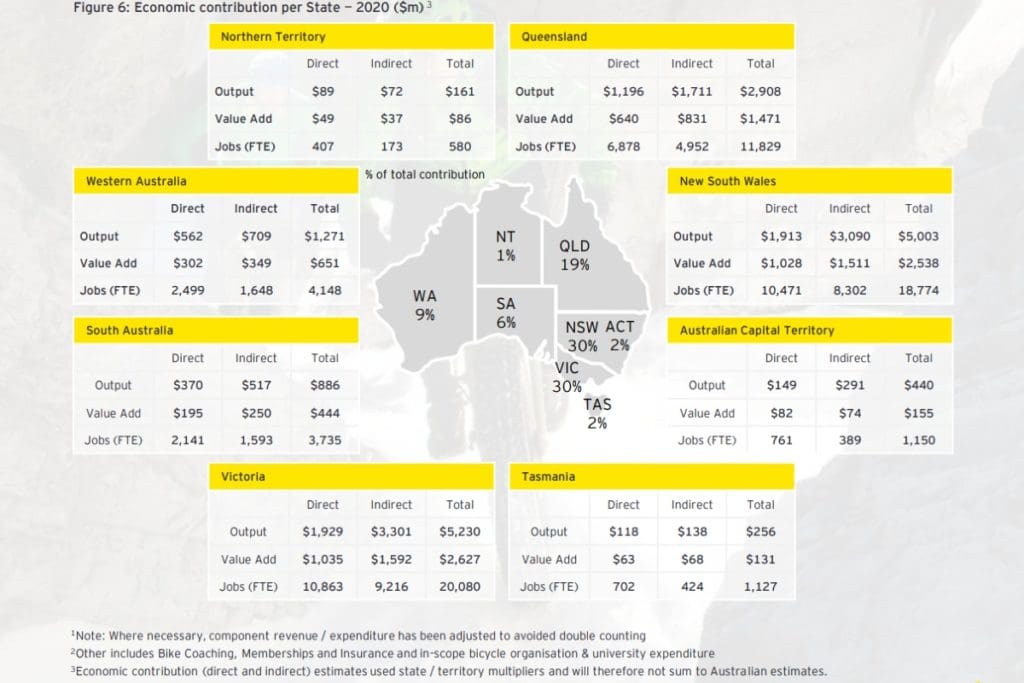
Cycling has been a major part of the Aussie Lifestyle and one of the few positive effects of the COVID epidemic as well. There has been a sharp rise in bicycle ridership. Over the past 18 months, a large number of Australians have resorted to cycling for both their fitness and social needs as gyms, swimming pools, and other health facilities have been frequently closed.
First off, cycling has produced employment possibilities in a number of sectors, including retail, maintenance, and bike manufacturing. According to the Australian Bureau of Statistics, the cycling business in Australia employs more than 20,000 people and brings in more than $2 billion annually. This sector also includes bike-sharing programs, which offer an affordable and environmentally friendly mode of transportation in urban areas and have generated new employment possibilities in the management and maintenance of bicycles.
We Ride Australia and Ernst & Young (EY) conducted a study to determine the economic impact of cycling in Australia in order to comprehend just how important cycling has grown to be there.
The study, which was published today, claims that Australia’s economy benefited from cycling to the tune of $6.3 billion in 2020. According to this statistic, “economic activity directly produced by bike riders, organisations, municipal and state governments provision of infrastructure to events, research, sport, and recreational cycling” is included.
The “direct value increase” of cycling to Australia’s GDP was calculated to be $3.4 billion. That is equivalent to the contribution made by the Australian thoroughbred business and more than three times what the country’s motorsport industry contributed.

The study, which was published today, claims that in 2020 cycling helped the Australian economy in the amount of $6.3 billion. This statistic takes into account that economic activity is directly produced by bicycle riders, organisations, and local and state governments’ supply of infrastructure to events, research, and sport and recreational cycling.
Meanwhile, it was calculated that cycling contributed $3.4 billion in “direct value increase” to Australia’s GDP. That is equal to or greater than the contribution made by the Australian business and more than three times the contribution made by the Australian motorsport industry.
Key findings are as follows:
- Governments invested more than $428 million in cycling-related initiatives and infrastructure.
- There were 60,330 direct and indirect jobs supported nationwide by a total of $16.8 billion in direct and indirect economic contributions.
- 5.8 million (29%) of adult Australians spent money on products and services linked to cycling.
- Australians rode at least once a week and spent money on it—3.3 million people.
- All cyclists who made purchases paid an average of $990 each.
- The bulk of buyers had annual household incomes between $50,000 and $150,000.
- Children’s bicycles made up 28% of all bicycle purchases.
- In 2020, 1.7 million bikes valued at $1.5 billion were bought.
- Cycle tourism contributed $1.168 billion to the immediate economic output.
- While 82% of those questioned said they rode their bikes for fitness and exercise, 41% said they rode their bikes for transportation, whether it be to work, school, or the store.
EY and We Ride point out that while the economic benefits of cycling were taken into account for their study, there are other benefits as well.

It is acknowledged that the physical activity benefits of cycling participation support wider health and well-being, and social and productivity benefits to the Australian economy, even though this research concentrates on the economic contribution of the industry. By easing traffic and offering a sustainable transportation choice, cycling as a method of transportation can also help local communities.
Australia’s rising popularity of cycling has given rise to new business possibilities for trip operators, bike rental businesses, and lodging facilities that are bike-friendly. These companies supply the increasing demand for bicycle tourism in Australia, which draws both domestic and foreign tourists. Australia’s natural grandeur is highlighted by cycling routes and trails, which also offer a distinctive and eco-friendly travel experience. In reality, it’s estimated that the Australian economy earns more than $1.2 billion a year from cycling tourism.
Furthermore, it has been demonstrated that cycling lowers healthcare costs by encouraging physical exercise and lowering the prevalence of chronic illnesses. Regular cycling can help people manage their weight, reduce stress, and improve their cardiovascular health, all of which can result in reduced healthcare costs for both the individual and the healthcare system. Cycling also encourages mental health and well-being, which is crucial in lowering the price of treating mental diseases.
Additionally, cycling is good for the environment and for everyone’s well-being. Cycling has a positive effect on public health because it reduces air pollution, carbon emissions, and traffic congestion. Cycling is a sustainable mode of transportation that lowers the carbon footprint of people and the economy as a whole. Lower air pollution has been related to lower rates of cancer and respiratory disease.
The growing interest in environmentally friendly transportation and the growing knowledge of cycling’s health advantages have both benefited the Australian cycling business. We can anticipate more economic benefits in the future as Australia’s cycling sector continues to expand. To guarantee the sustainability and expansion of the industry, it is crucial for the government and companies to keep funding cycling infrastructure and promotion.
Through the establishment of jobs, increased tourism, and better public health, cycling has grown to be a significant economic force in Australia. The bicycle industry in Australia is expanding, so it’s critical that companies and the government continue to fund infrastructure improvements and marketing campaigns for the sport. The advantages of cycling are obvious, and with continued funding, Australia can anticipate additional economic gains in the future.
